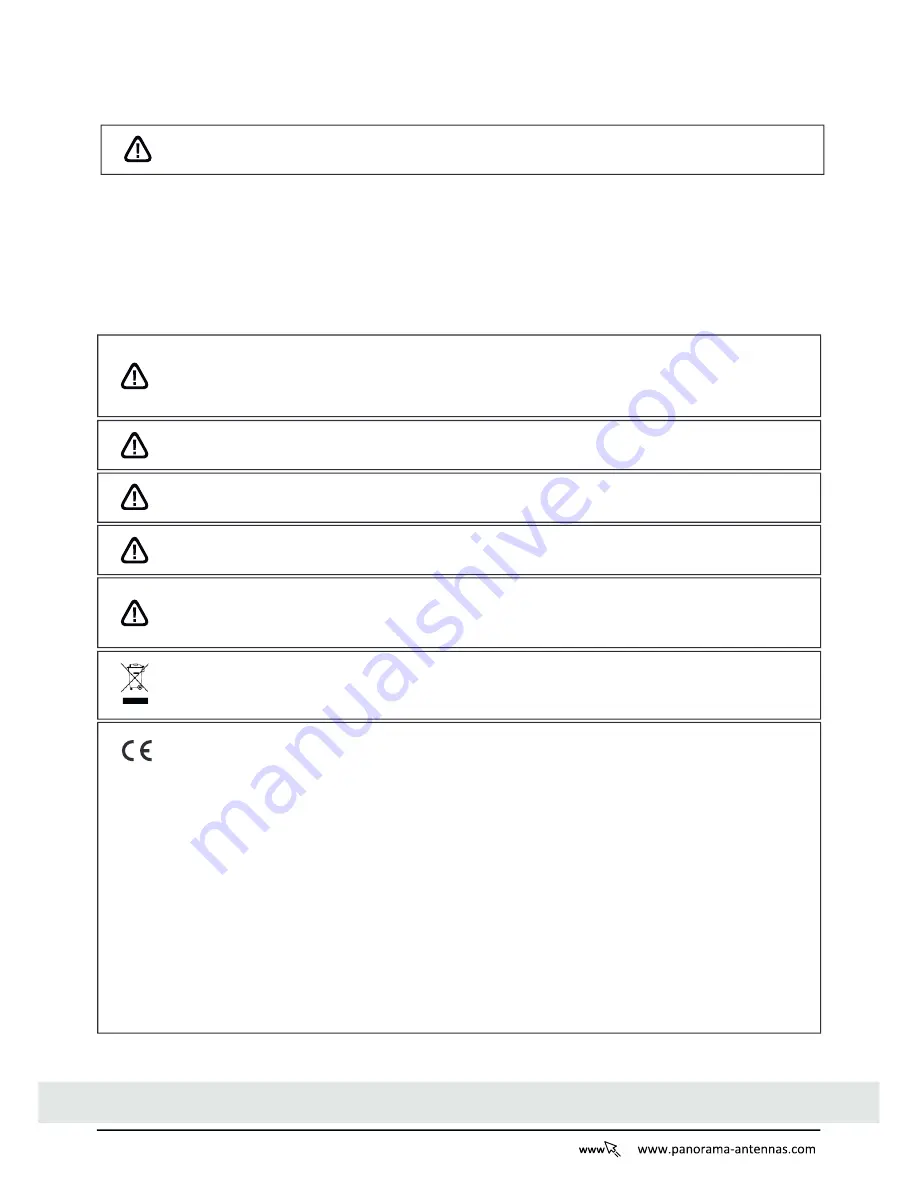
Waiver: This document represents information compiled to the best of our present knowledge. It is not intended to as a representation or warranty of fitness
of the products described for any particular purpose. This document details guidelines for general information purposes only. Always seek specialist advice
when planning installations and ensure that antennas are always installed by a properly qualified installer in compliance with local laws and regulations.
Head O
ce
61 Frogmore, Wandsworth, London, SW18 1HF, UK
General Safety Note -
Make sure that the product is mounted so that it cannot fall and cause injury. Do not chew the product or put it in your
mouth. Do not leave children unsupervised with the product or packaging.
Waste electrical products should not be disposed of with household waste. All electronic products with the WEEE logo must be collected and
sent to approved operators for safe disposal or recycling. Please recycle where facilities exist. Many electrical/electronic equipment retailers
facilitate “Distributor Take-Back scheme”for household WEEE. Check with your Local Authority or electronic retailers for designated collection
facilities where WEEE can be disposed of for free.
Directive 2011/65/EU (RoHS 2)
RoHS 2 compliance is declared per Directive 2011/65/EU and its subsequent amendments with exemption 6.c applied.
REACH (Registration, Evaluation, Authorisation and Restriction of Chemicals, EC 1907/2006)
This product contains Lead (CAS No. 7439-92-1) which is classified as an SVHC (Substance of Very High Concern) as being toxic to
reproduction under Article 57c. of REACH. Do not chew parts or put them in mouth, keep away from unsupervised children. Dispose of parts
as WEEE waste do not send to landfill.
This declaration is issued under the sole responsibility of the manufacturer
The object of the declaration described above is in conformity with the relevant Union Harmonization Legislation below:
Directive 2014/53/EU
Radio Equipment Directive (RED)
Harmonised Standards and References:
EN 301 489-1 (V2.1.1): “Electromagnetic compatibility and Radio spectrum Matters (ERM); Electro Magnetic Compatibility (EMC) standard for
radio equipment and services; Part 1: Common technical requirements”.
Referencing EN 61000-4-2:2009 – Electrostatic Discharge Immunity and EN 61000-4-3:2006 +A1:2008 +A2:2010 – Radiated RF Immunity
EN 300 440-1 V1.6.1 (2010-08) – Electromagnetic compatibility and radio spectrum matters (ERM); short range devices; radio equipment to
be used in the 1GHz to 40GHz frequency range; Part 1: Technical characteristics and Test methods in accordance with EN 300 440-2 V1.4.1
(2010-8) - Electromagnetic compatibility and radio spectrum matters (ERM); short range devices; radio equipment to be used in the 1GHz to
40GHz frequency range
Low Voltage Directive: Directive 2014/35/EU (Electrical Equipment designed for use within certain voltage limits) of 26th February 2014.
EN62368-1: 2014 Audio/video, information and communication technology equipment. Safety requirements
Do not chew parts or put them in mouth, keep away from unsupervised children.
Dispose of parts as WEEE waste do not send to land
ll.
Important Note Regarding Sealing
-
TIn order to ensure that the installation is properly sealed against the mounting surface care must be
taken regarding curvature of the mounting panel. It is highly recommended to install the antenna on a clean, flat and level surface. After installa-
tion the compression of the rubber boot against the mounting panel should be checked and a small bead of neutral cure silicone sealant can
be applied around the periphery of the mounting boot if requried. It is important that the periphery of the antenna is sealed and that no moisture
is allowed to penetrate under the antenna boot.
Electrical Safety Note
-
The GPSD and SHK[G] contain an active GPS/GNSS antenna. Rated voltage: 3-5VDC Rated current: 20mA
maximum. The supply to this device must be provided with overcurrent protection of 1A maximum.
DO NOT -
• operate the transmitter when someone is within 20 cm of the antenna.
• operate the equipment in an explosive atmosphere.
• chew parts or put them in mouth, keep away from unsupervised children.
CAUTION
-
To comply with FCC RF Exposure requirements in section 1.1310 of the FCC Rules, antennas used with this device must be
installed to provide a separation distance of at least 20 cm from all persons to satisfy RF exposure compliance.
When routing the cables take care to avoid running them adjacent to any existing vehicle wiring or fouling any moving vehicle components. The
cables must not be routed in front of any airbag device.
4. Routing and terminating coaxial cable(s)
If heat shrink tubes are to be used, slide onto antenna cable tails prior to connecting extension cables – it is recommended that these are heat shrunk only
after all tests have been satisfactorily completed. Connect extension coaxial cables to antenna, ensuring that the connectors are fully inserted and tightened,
then route to equipment. Fit correct coaxial connector or adapter to cables as required.
5. Commission and test
Check GPS/GNSS cable (where applicable):
●
Check the GPS/GNSS cable with DC to measure high resistance.
●
Connect the GPS / GNSS cable to the GPS/ GNSS receiver and check for satellite acquisition.
Check comms cable(s)
●
Carry out VSWR check, should measure <2.5:1 in transmit band (antenna type dependent).
●
Connect Cellular/ LTE & WLAN cables as applicable or stow unused pigtails.
6. Notices




















